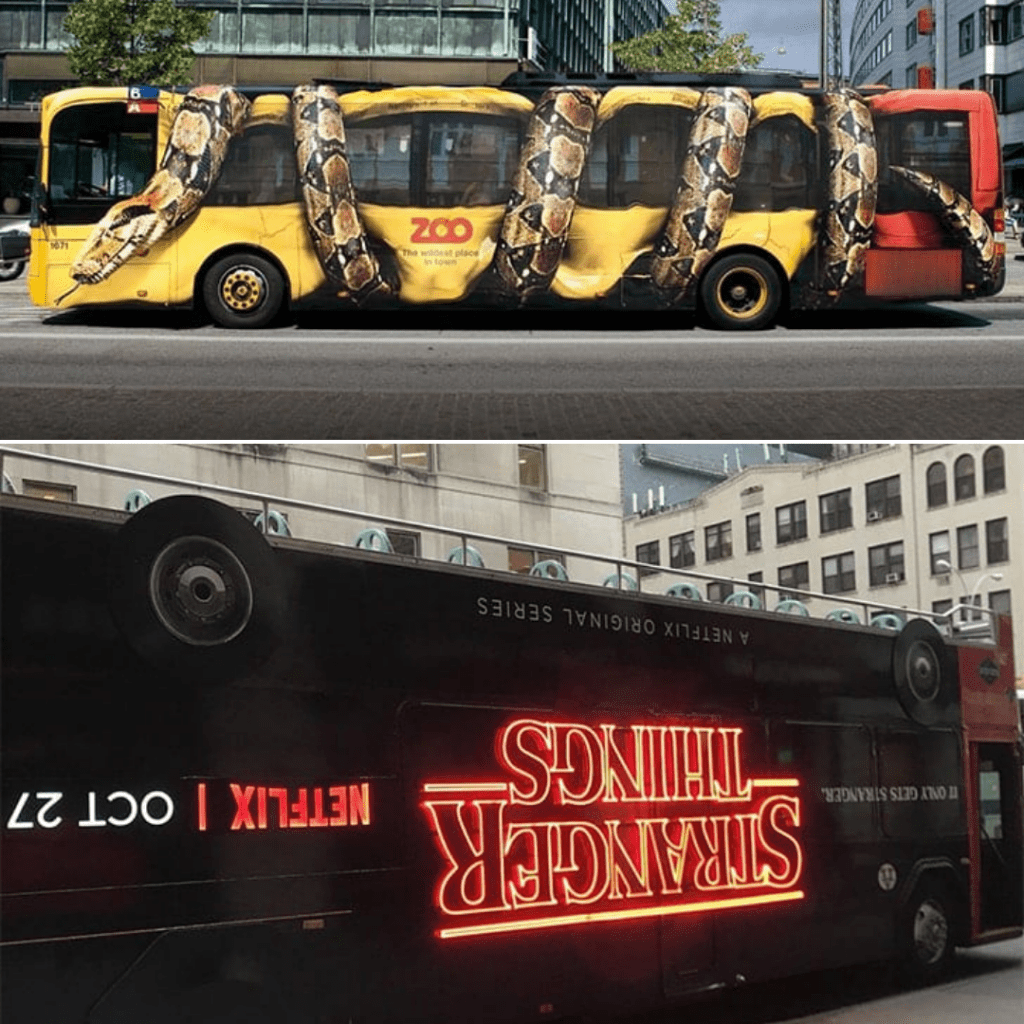
Buses take the static out of advertising because they essentially inject some life into the product being marketed. They are creative moving canvases that provide various marketing tactics, with moving parts like the doors, ensuring maximum effectiveness.
The digital world is highly competitive, and resourceful agencies know that traditional outdoor advertising, with an original twist, still has the power to make an impact. Most employ tactics like strategically placing the artwork on different parts of the bus or using optical illusions to make a lasting impression. It’s best to show instead of just talking about it, and these eye-catching and thought-provoking “busvertising” campaigns say it all.
Buses also provide the space for interior adverts, and on a jam-packed bus, people get something to look at during the commute. Statistics suggest that 75% of indoor ad consumers take action based on the call-to-action after seeing these marketing campaigns.
Crushing Adventure
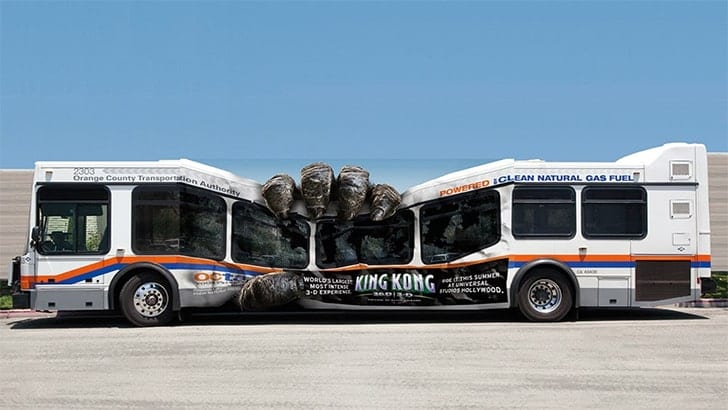
Bus advertising is one of the popular forms of out-of-home (OOH) marketing. It essentially does what’s implied, that is, reaching people when they are out and about. Bus adverts fall under the OOH transit category.
Now, this is a classic example of an “Ultra Super Kings” bus advert that covers the entire surface area of the bus for maximum impact. What better way to advertise a blockbuster than to “wrap” the whole bus in line with the film’s theme. Take this perfectly executed crushing bus effect, which sells the adventure film, King Kong. We imagine almost everyone who came across this bus was compelled to go and watch the movie.
Bus advertising generally falls into four main categories. King and Queen signs are the largest taking up either side of the transit vehicle. Tail signs conveniently cover the rear end. There’s also space for interior advertising located inside the bus. Wraps are newer developments covering the entire vehicle.
Sailing Through The Bad Weather
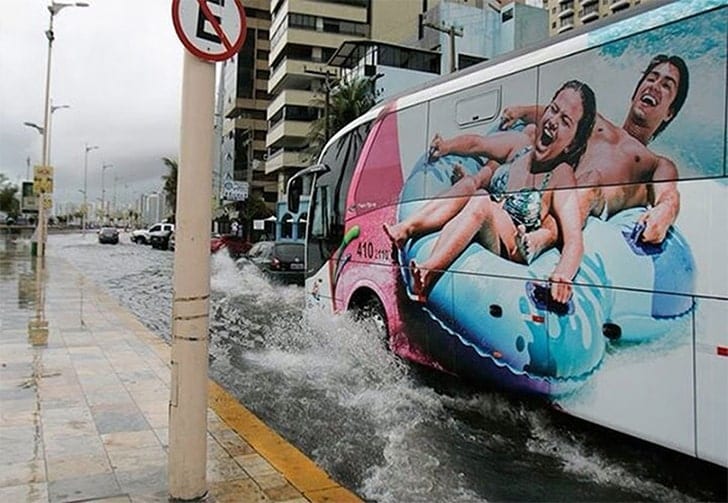
The weather can ruin your day, particularly if you are caught in a downpour. Worse still, you might be the victim of a splash from a vehicle that drives over the puddles that collect on the road after it rains.
This is a perfectly timed photo that gives a twist to this bus advertisement. We are not sure about the origin of the advert, but it could be a tour company. Bus advertisements are all about a colorful design accompanied by some short copy. It must be eye-catching to grab everyone’s attention at first sight, and the ultimate goal is to leave a lasting impression. This perfectly timed photo helped this brand traverse different mediums.
Exterior bus ads make the most impressive because they aren’t only limited to reaching commuters but everyone who comes across the ad-on-wheels. Consumers are generally 33% more alert/aware outside their homes, and that makes these transit ads more effective.
Snake On A Bus

Snakes on a Plane move over, we have a new conversation piece through this slithering ad campaign put together for the Copenhagen Zoo. Peter Schack, the art and creative director at Bates Y&R, was the brains behind this highly impactful yet budget-friendly concept.
Schack and his team created the illusion by melding high-resolution images taken of the standard city bus with the photo of the gigantic boa constrictor. They were going for a real as it gets effect, and they accomplished it. The bus even became a tourist attraction in itself because people couldn’t resist snapping photos of it and sharing them on social media.
People are receptive to images, and advertisements that employ the use of this tool combined with captivating designs, can get their work more than half-way across. Bus adverts also tend to keep the wording on the minimal side, because the visuals are truly the show-stoppers.
The Panda Express
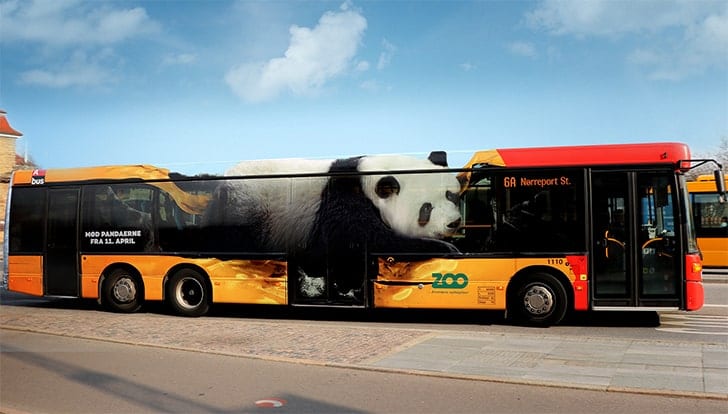
With transit adverts, people don’t get the chance to look over the message for long. That’s why they use bright colors and images to attract attention, and this Copenhagen Zoo advert hits the nail on the head.
Simplicity is also vital, and that’s what we get with his bus advert. If you ask us, there’s no better way to sell a zoo than to include one of the most adorable creatures on the planet in the ad campaign. We are talking about the panda, which is one of the zoo’s main attractions. Other attractions housed at the zoological garden include lions, arctic foxes, Asian elephants, and white rhinos.
The Copenhagen Zoo opened its doors in 1859, making it one of Europe’s oldest zoos. Sir Norman Foster, the British architect, designed the popular Elephant House attraction, which was launched in 2008. Two glass-domed encloses house the zoo’s population of Asian elephants.
Get Ready For An Adventure
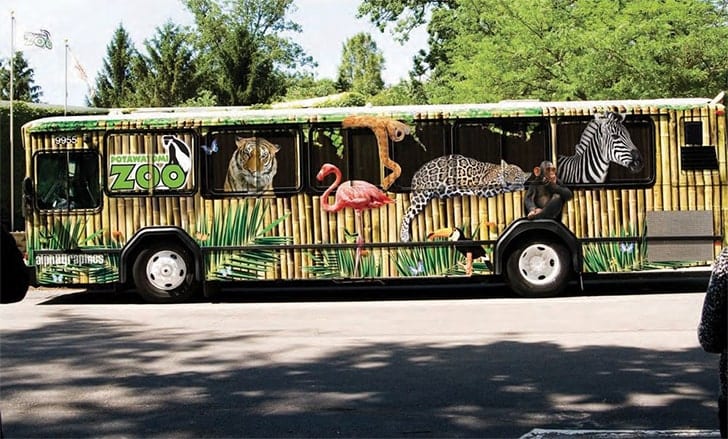
Nestled in South Bend, Indiana, is the Potowatomi Zoo. The zoo opened its doors in 1902, making it the oldest in Indiana.
The zoo aims at improving the quality of life of the animals in their care. They are also dedicated to conservation efforts and educating the population as a whole about the over 400 animals under their supervision. Their bus advert is enough to get anyone excited about the prospect of seeing all those animals in their sanctuary. The choice of animals depicted on the bus reminds us how the world is big enough allowing us all to coexist peacefully.
The Potowatomi Zoo opened its two latest attractions in 2016. The Endangered Species Carousel ride includes 18 hand-crafted friendly creatures like leopards, zebras, and lions. Their Zoo Train ride takes visitors on a historic trip around the western side of the zoo aboard an electric train.
Stranger Things On The Highway
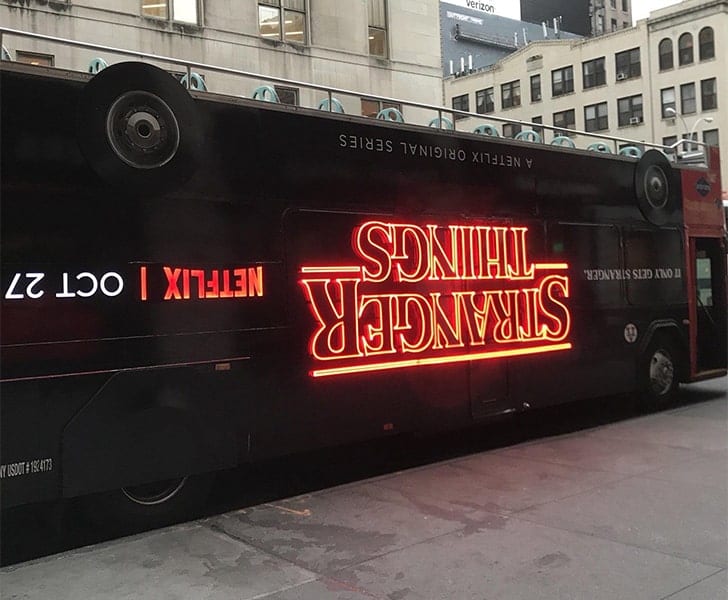
Some say the world wasn’t complete until we were first treated to the Netflix sci-fi horror Stranger Things. The show taught us to believe in the unexpected, and this advert just about sums it up.
Stranger Things fans are familiar with the alternate dimension explored during the show’s first season - the Upside Down. The Demogorgon, a humanoid monster, inhabits the parallel yet soulless universe that mirrors our own. The Demogorgon’s favorite pastime is feeding on eggs when it isn’t busy abducting children. We imagine anyone who comes across this bus on the highway will agree that they’ve seen way stranger things on this planet.
Anyone who hasn’t feasted their eyes on the peculiarness that is Stranger Things has three binge-worthy seasons to get through. That’s while the rest of us wait for the Duffer Brothers to roll out the fourth season, possibly sometime in 2021, given the pandemic.
Save Yourself From A Fender Bender
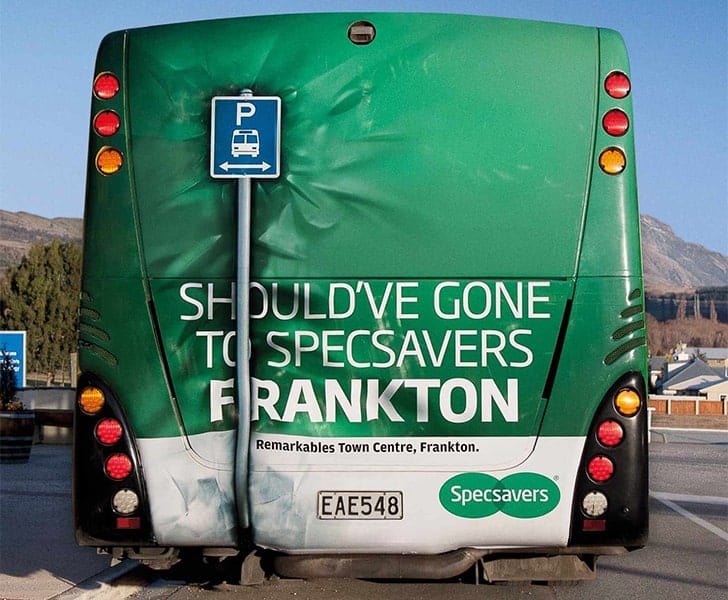
Did the bus just hit a pole, or is it some smart bus wrap work? The 3D effect is quite realistic; you have to look twice to make sure that you don’t need to get your eyes checked.
Any vehicle that trailed this bus got the vivid message that they might need some Specsavers intervention. We are only curious about how the conversation goes when officers pull this bus over. Let’s not forget the number of calls that are made about a bus that seems to be dragging a pole with it. We also have to admit that we didn’t get it until we looked up Specsavers, so mission accomplished.
According to The Canadian Out-of-Home Marketing and Measurement Bureau, transit adverts and OOH ads, in general, have a quick reach. In turn, that results in a good return on investment. These forms of advertising also generate emotional connections and viewer interaction.
Eaten Alive
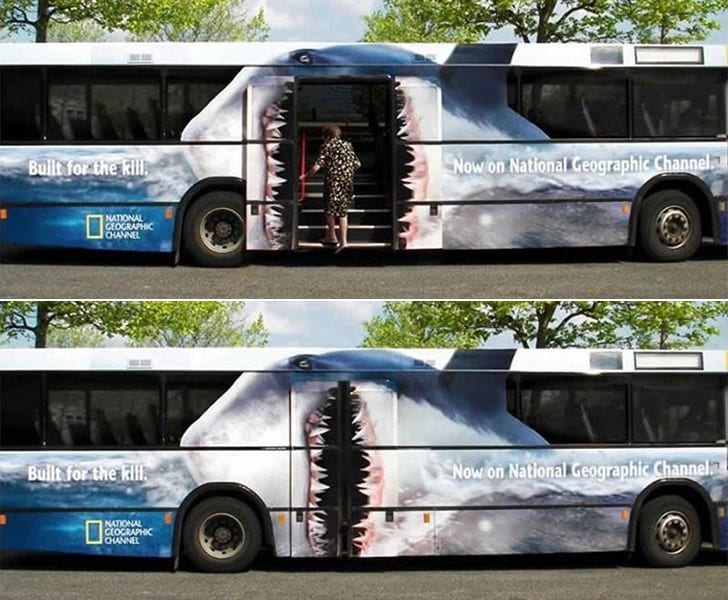
Step right into the open jaws of danger, those menacing words would have shaken the best of us, and we are happy they are not part of this National Geographic ad campaign.
This is a prime example of great utilization of the bus doors because it gives you a vivid image of what the show is all about. This creative advert marketed Built For The Kill, a National Geographic show. They employed the use of a shark, which is one of the animals featured in the docu-series. They strategically wrapped the bus in such a way that the shark’s mouth was at the bus entrance.
Transit ads may also fall under the guerrilla marketing category, where companies use ordinary everyday items combined with the element of surprise to promote their products/services. The aim, in this case, is to generate publicity through personal interaction while using low-cost marketing strategies.
Inspiration To Quit Smoking
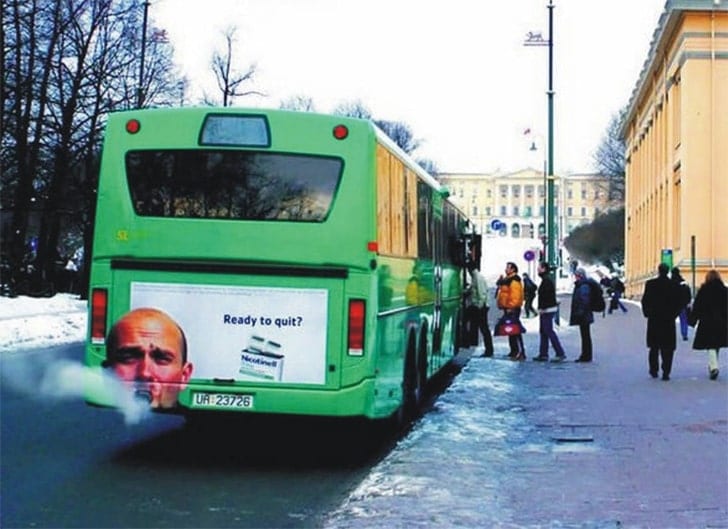
Campaigns that make use of transit vehicles often attempt to pass the message across in a way that warps people’s perspective. That means using the wheels, passengers sitting in the window seats, lights, wheels, or even the exhaust pipe.
This bus makes use of the strategy and leverages the environment to get the point across. Consumers like the feeling of being in on it, and bus adverts that make the most impact try to inject some humor in the process. When the bus is in motion, this man seems like he’s smoking like a chimney. It’s a reminder that Nicotinell gum can help him quit.
When working on bus adverts, it makes sense to be contextually relevant. The demographic that encounters the bus is equally essential, and that means targeting a bus route that encompasses target communities. It also helps to integrate the advert with the environment around.
Saving Lives
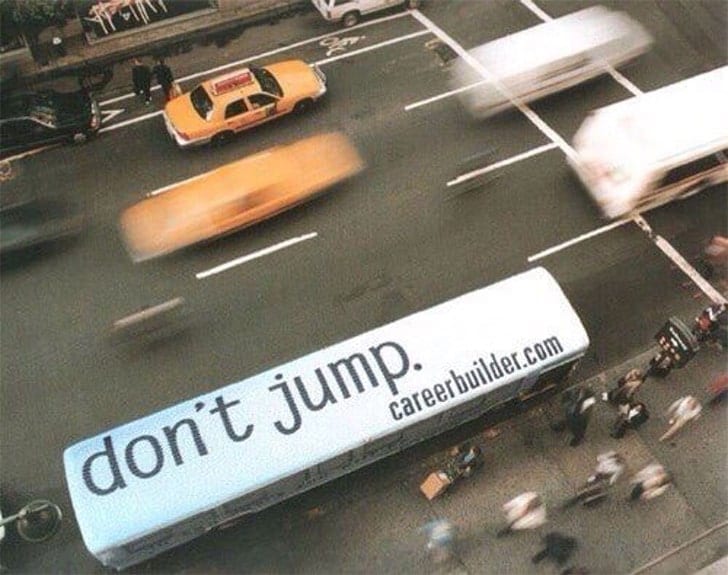
David Ogilvy, dubbed the father of modern advertising, famously said that a great ad campaign sells a product without necessarily drawing attention to itself. The key is creating an advert that is both clever and impactful but doesn’t come off as overpowering.
Careerbuilder employed the use of this creative and perfectly executed ad, which is mostly only visible from a particular vantage point. It holds a profoundly deep and genuine meaning to the scores of jobless people who are sometimes pushed to the edge of taking that jump off the rails. The message is clear, before taking that plunge, visit careerbuilder.com.
One of the advantages of transit advertising is the fact that you can’t ignore it. It isn’t a TV commercial that you can skip by changing the channel or a newspaper ad that you can overlook by flipping the page.
Chasing The Dog Food
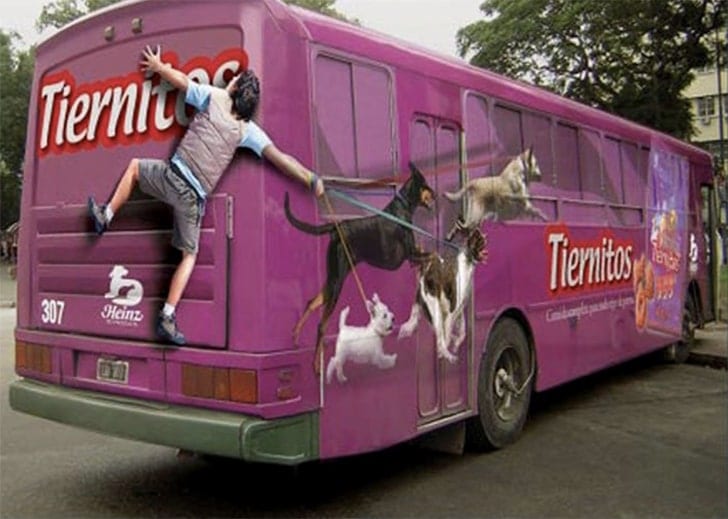
Dog owners watch out, Tiernitos is that dog food brand that your furry friends can’t resist. You might just find yourself caught up in a race for the best when your companions spot their favorite treats.
The advertisement makes use of the back panel and side of the bus to pass the message across. Not only is it hilarious and eye-catching, but it sells the product in the simplest of ways without too much text. The pet food brand goes above and beyond to make their advertisements stand out. It looks like the poor guy in the advert even smashed into the bus as the pups ran towards their meal.
Transit adverts are not only restricted to public buses. Some brands choose to place their ads on the roof of taxicabs, the side and inside of trains, and delivery trucks or company vehicles. However, state regulations vary, and it may not be legal to brand your vehicle.
Accordion Bus
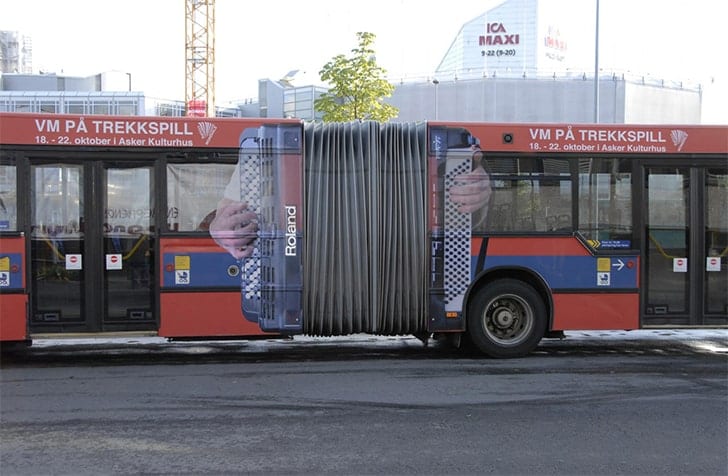
The best ad to go on an articulated bus is one advertising an accordion competition. Coupe Mondiale did just that with this advertisement.
Coupe Mondiale is an annual international accordion competition held in Asker, Norway. The Confédération International des Accordéonistes (CIA) is behind the musical competition. Articulated buses are typically single-decker vehicles with two or more sections that are articulated by a pivoting joint, and that makes it look much like the box-shaped musical instrument. They can accommodate a higher passenger capacity compared to rigid-bodied buses. Bus rapid transit systems greatly utilize these types of buses, and one can often carry around 200 people.
Transit advertisements go the full extent that allows the product to truly stand out. Ad agencies go for techniques like 3D printing, LED illumination, and special effects. Often, this drives the cost higher, but the potential to make a more significant impact is worth the effort.
A Transparent Ride
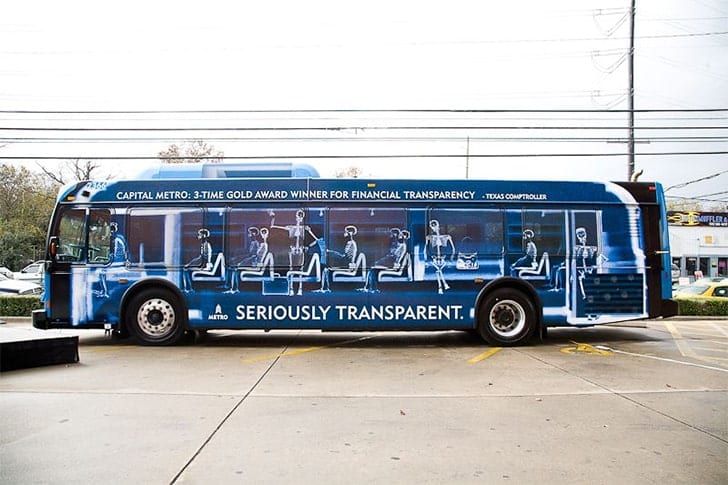
Reliability, low rates, and transparency are some of the aspects that you look for from a financial institution. That’s what Capital Metro promises, an experience that is all about financial transparency.
Mediacom and the University of Alberta studied 300 OOH campaigns, and they concluded that they are a stable marketing option throughout the year. The creative execution is the element that could affect the effectiveness of an OOH promotion at different times of the year. That’s why OOH transit buses have to go for as much creativity as possible to get noticed and retain the attention year-round. Simple ads also must have a creative twist in this space.
There’s no space for laziness when exploring any form of advertising. Literal ads that go the obvious route of stating facts have the least impact. However, advertisements that use a larger type size with shorter texts tend to have the most significant impact on transit vehicles.
Magical Disney Ride
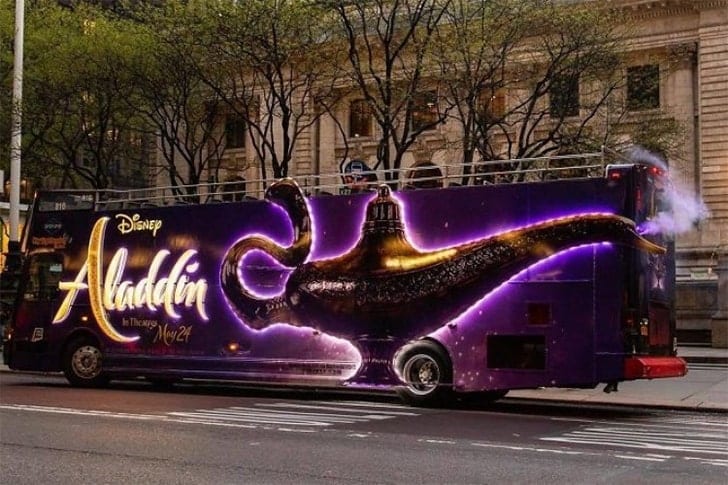
One look at this purple bus and the word that comes to mind is magic. You get the sense that you are about to go on a magical Disney ride when you step inside this bus.
This is yet another example of a bus advert that makes use of the exhaust pipe, with a lamp strategically positioned to churn out smoke. Nothing is lost in translation here, and you know that you should head to the theatre on May 29th to watch Aladdin. We are sure a couple of people couldn’t resist rubbing the lamp on the bus to see if they would get their wishes granted.
Transit advertising doesn’t end with placing ads on and in the vehicle. Brands also know that bus shelters, transit benches, and bus stops are other areas worth exploring. Interactive advertisements still create the most impact on these different forms of transit adverts.
Can’t Block This
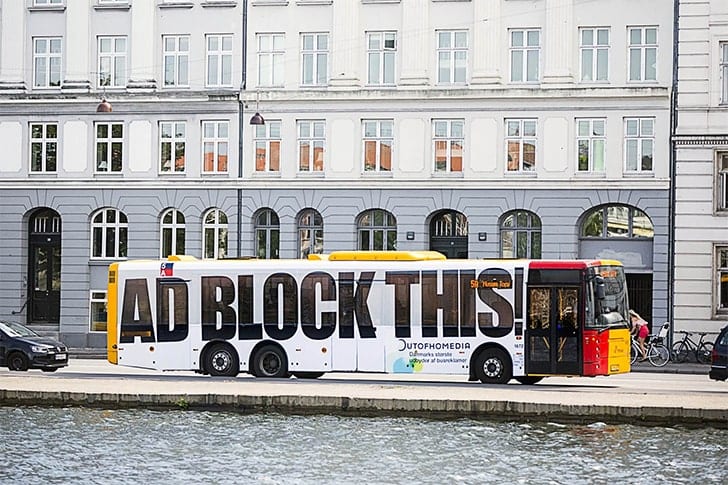
The first thing that is apparent about this advert is the fact that it sums up what transit ads are all about. You can’t install an ad blocker to prevent you from seeing the marketing campaigns plastered all over buses.
The campaign markets the Danish OOH marketing firm Out of Home Media. The message is that buses have a hand over web-based advertising because you can’t block out real life. In a practical sense, it’s impossible to forgo digital advertising for OOH marketing. However, we get the humor from this ad campaign created to market a company that’s all about OOH advertising.
Business Insider reported that between 2015 to 2016, the number of smartphone users with ad blockers on their devices grew. Their findings suggest that 22% of smartphone users globally were saying no to the invasive ads that popped up on their devices by blocking them.
Sailing By
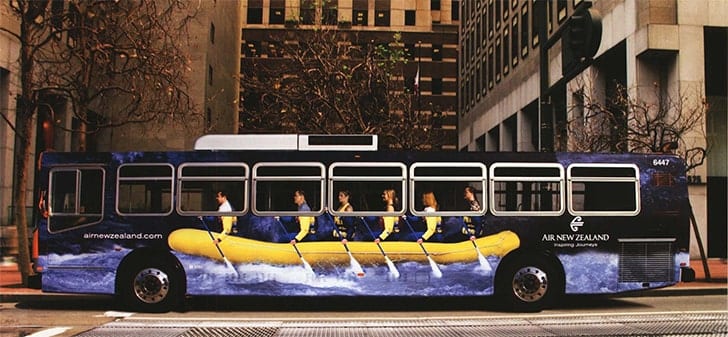
When Air New Zealand launched a non-stop service flying across several new destinations, they came up with 3D OOH campaigns to advertise the development. Their angle was painting New Zealand as an outdoor adventure destination.
Michael Barti, a writer and creative director, explained that they chose to depict the wintertime activities that NewZealand offered. The approach made the ads stand out in the U.S. during summer. They had a series of large-scale 3D billboards showing how Air New Zealand was inspiring new journeys. This bus advert was one of their OOH marketing efforts, and it cleverly makes it seem like the people sitting next to the window are sailing by.
Air New Zealand also had another bus advert that made it seem like the people sitting by the window were skiing. The call-to-action, in each case, reminded consumers that winter was only 12 hours away, and Air New Zealand was on standby to fly them to their desired destinations.
Boombox Bus
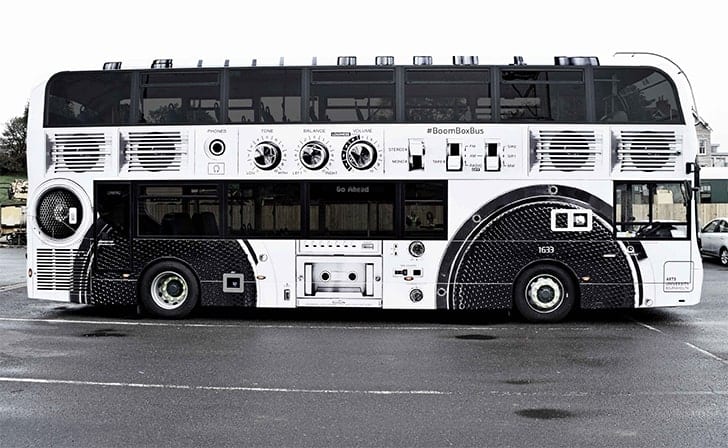
The Arts University of Bournemouth (AUB) decided to take us on a journey back to the good old days with this artistic boombox bus ad. These transistorized portable music systems came into the scene around the mid-80s, and this ad pays homage to the classic boombox design.
The 2016 bus advert aimed at showing how the school’s students could use their creativity to transform familiar surroundings by giving them a fresh perspective. Creative Forager came up with the bus advert, and AUB held a competition asking people to tweet photos they’ve taken on the giant retro blaster for a chance to win £150 ($194).
Most OOH marketing campaigns have a way of crossing over to the digital space. People who come across unusual ones can never resist snapping photos of these ads and sharing them on social media. The commercials get a renewed life when some of these photos go viral.
Flexible Trip
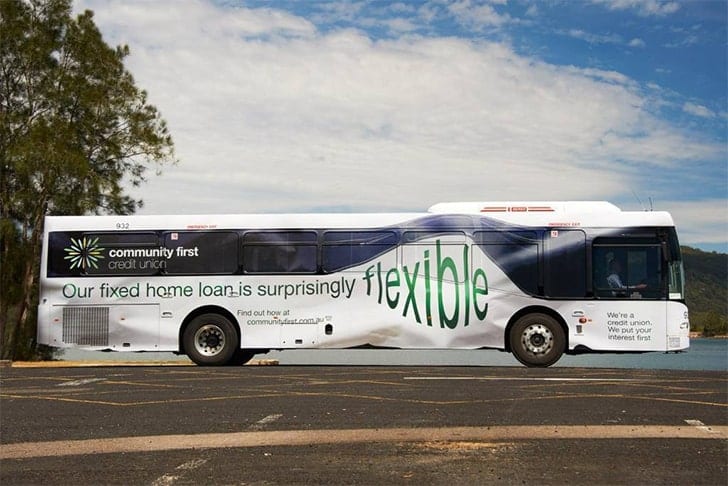
Some of the things that consumers want out of a loan is a fast application process, low rates, and the flexibility to make early or late payments when necessary. Community First Credit Union promoted the flexibility of its home loans with this bus advert in Australia.
One of the problems a few people had with what they promise is the fact that they are talking about fixed home loans. These types of loans are not known for their flexible nature, but perhaps, they are referring to the diverse ways applicants can use the loan. Either way, the optical illusion is eye-catching.
Optical illusions are a great strategy to use in advertising when showing two different perspectives. Technology has made it easier for graphic artists to include them in ad campaigns. The whole point is to spark debate by raising questions about perception.
Gone In One Bite
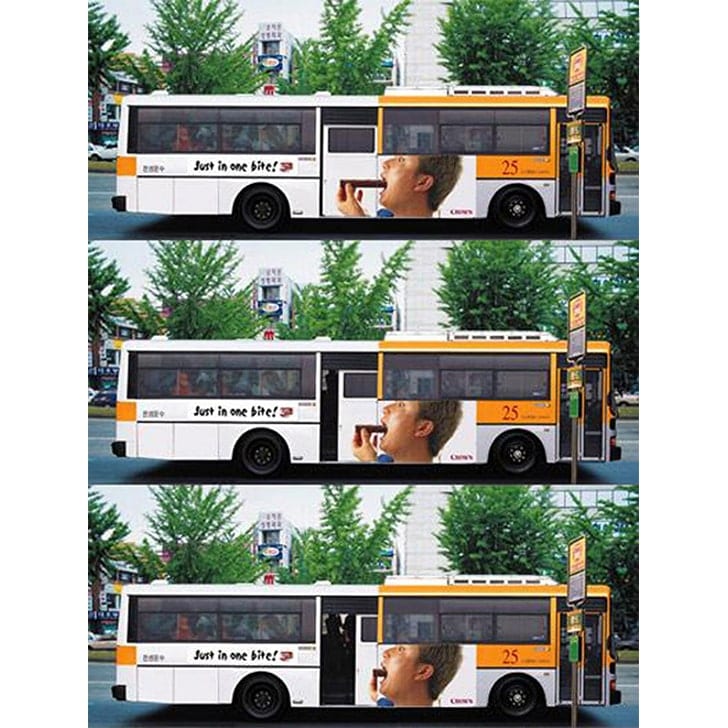
The majority of us find chocolate treats irresistible, and all it takes is one bite to get rid of the evidence. That looks like the idea that this bus advert pursued.
It’s tricky business placing an ad on the door of any vehicle. This one works because when the door opens, the chocolate does indeed disappear in just one bite. However, it leaves the man’s hand looking awkward because it is cut off. The problem is worse when there are words over the door, like the viral Starbucks van photo, which gives the brand a whole new meaning when the door is open.
Windows are equally tricky spots to place image adverts. When they are opened, it could distort the meaning of the text plastered on them or leave the images looking somewhat questionable. It calls for some strategic thought about where words should go.
Airing Your Dirty Laundry
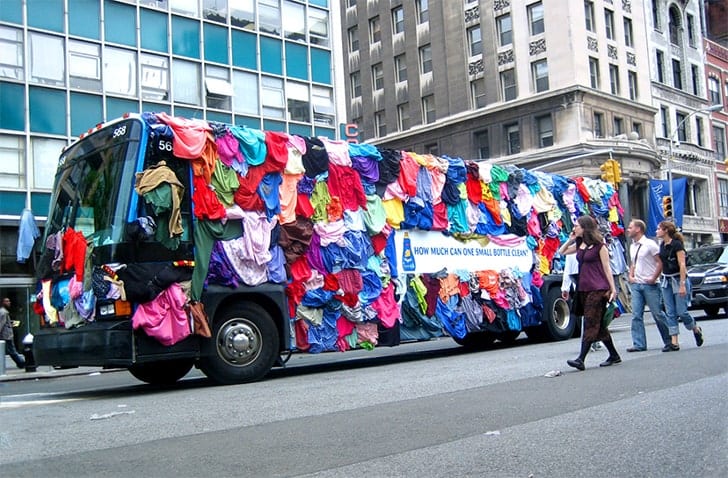
It doesn’t get as literal as this photo when they say that you shouldn’t air your dirty laundry in public. The bus doesn’t look that great at first glance loaded with all those clothes.
When you realize that it’s an over the top bus advert for the All Small & Mighty laundry detergent, it makes more sense. The bus, covered in an estimated 32 loads of laundry, took to the streets of New York in 2006, and since then, it’s said to have driven more than 5K people to visit the product website. After all, no one can avoid staring at a pile of laundry that’s moving around the city.
Installation advertising incorporates the surroundings where an ad is placed to make it an attraction in itself. Pantene drew inspiration from Rapunzel and set up an oversized ponytail falling from the side of a building to advertise the strength of their anti-breakage shampoo.
Windows To The Soul
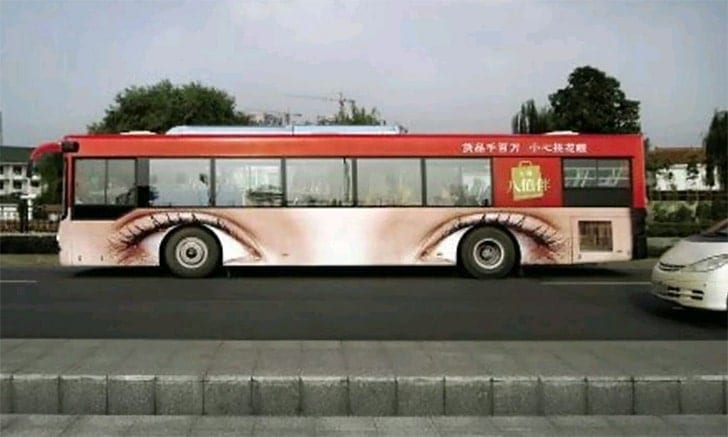
The wheels of a bus provide an opportunity to create some whimsical yet thought-provoking ad campaigns.
This ad is set on the wheels in such a way that they look like a pair of eyes. They must not be the easiest of things to look at when the bus is in motion. Just looking at this photo makes us feel like we are about to get hypnotized. Looking up the ad, we were surprised that it’s advertising the Yaohan shopping mall in Shanghai. We would have thought that it had something to do with promoting an eye-related product or service.
We’ve also seen busvertising campaigns that promote car-hire services or motorbikes plastered on the bus close to the wheel area. The wheels are the parts that keep the bus in motion, and therefore, they offer an endless list of possibilities in terms of product placement.
Picture Perfect
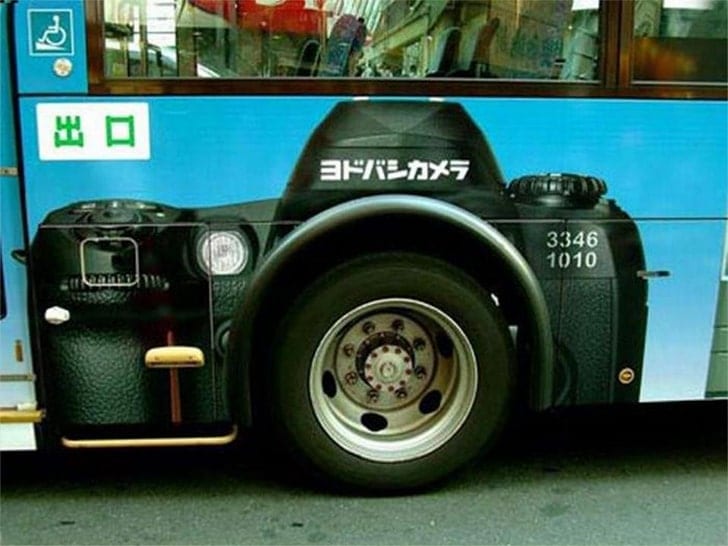
Giant buses in slow-moving traffic around urban areas translate into high-visibility marketing spaces. The brains behind this Canon camera advert knew it, and they strategically chose a wheel placement.
Outdoor Advertising Association of America, the trade association, estimates that about 205K buses move around the country with adverts placed on and/or in them. The resurgence of OOH marketing is credited to the advancements in print production techniques. Just about every brand is now jumping on the traveling billboards bandwagon because they understand its reach. The large decals offered through the moving parts of a bus give such adverts a new twist.
Out of the $166 billion generated by ad sales in the U.S. back in 2015, OOH marketing campaigns accounted for $7.3 billion of the total. That translates to 4.4% of the ad revenue generated that year, and 18% of it is said to have come from transit advertising.
Stop Human Trafficking
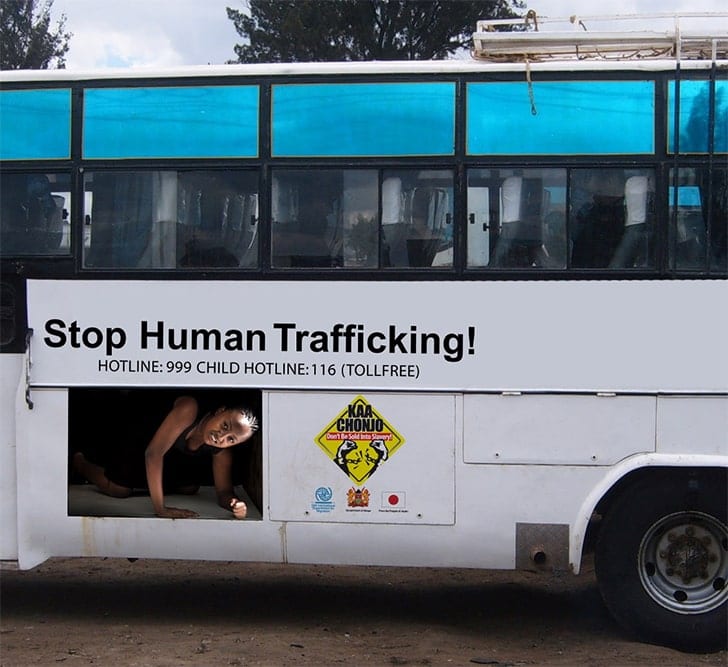
Since 1951, the International Organization for Migration has been at the forefront of advising and providing services related to migration on a global scale. One of their efforts has been to stop human trafficking, and one of their tactics has been using bus adverts like the one pictured.
The highly disturbing bus campaign goes for the shock factor, and that is the point. The message supports it; we need to stop human trafficking entirely because it is one of the most inhumane acts ever. Even more disturbing is the fact that human trafficking happens all across the world, far too often than the issue is addressed.
Eden is a gut-wrenching movie that was released in 2012. It was loosely inspired by Chong Kim’s story, a Korean girl who immigrated to America with her parents only to get trafficked. Breaking Out, a non-profit, investigated Kim’s story in 2014 and concluded it was fake.
Spicy Fiery Bus
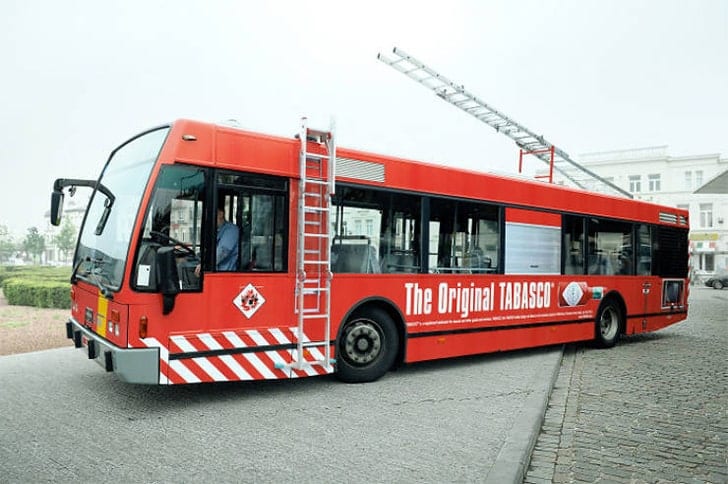
Be warned; there is a fire engine on the loose! This spicy and fiery creation is aimed at promoting the original Tabasco sauce. The hot set of wheels is bound to have people stopping to stare wherever it goes.
We get it, they are warning us that things are bound to get hot with a bottle of the sauce, and we might just need to call a fire truck. There are many ways to interpret it, but it all comes down to telling us that we need some spice in our lives. We are not sure about the two ladders, which may cause height clearance issues.
A couple of bus adverts are not exactly meant to be mobile for long. Take the Jaguar E-PACE SUV holiday campaign. The vehicle was set in a hollowed-out double-decker, with a glass panel giving a sneak peek of the luxury car.
Lopsided Bus
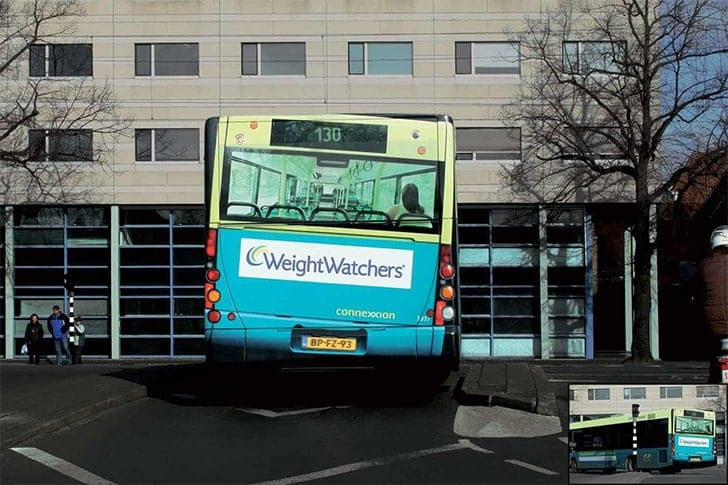
One of the toughest conversations is the one we have with ourselves when we know that we need to lose a couple of pounds. It’s a tough one because you never want to admit that you have a problem that needs fixing.
This Weight Watchers bus advert doesn’t take the most sympathetic route, but it drives the point across. It makes the use of some lopsided graphics to make it look like the bus is carrying a bit more weight on one side. Most of us can relate to feeling like we are carrying a few extra pounds, making the advert relatable as much as it is humorous.
Another similar type of in-your-face advert we’ve seen is that of a public transit double-decker bus with the image of a mini-bus plastered on its side. The product in question was a detoxifying pill that promised to help slim down your body.
Powered For The Ride
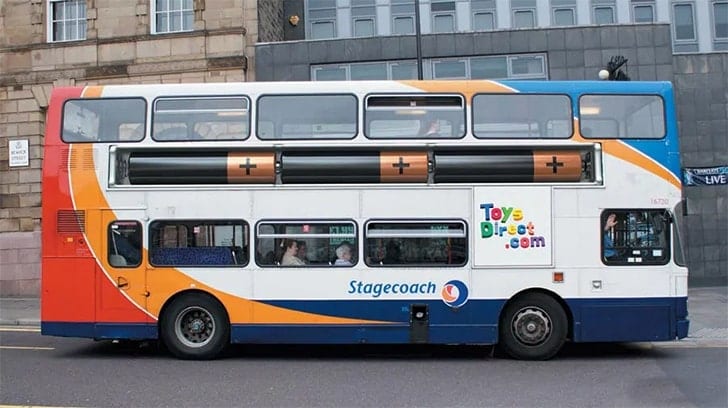
ToysDirect.com is behind this creative advert that certainly inspires imagination. That’s what toys essentially do; they make us dig deep into our imagination to believe in the impossible. The fun design also makes the vehicle seem like a life-sized toy bus.
The giant triple-A batteries give the bus that toy-like appearance, and that’s typically their placement on battery-operated toy buses. The design provides a whole new meaning to the expression of treating the world as a playground. It speaks to our inner child, and anyone who feels the same would visit the website to see what they have in store.
One of the setbacks of OOH advertising is the inability to validate who comes across the ad at any given time. On the other side, it’s possible to authenticate if the right demographic, based on aspects like leads and sales conversion.
The Lift-Off
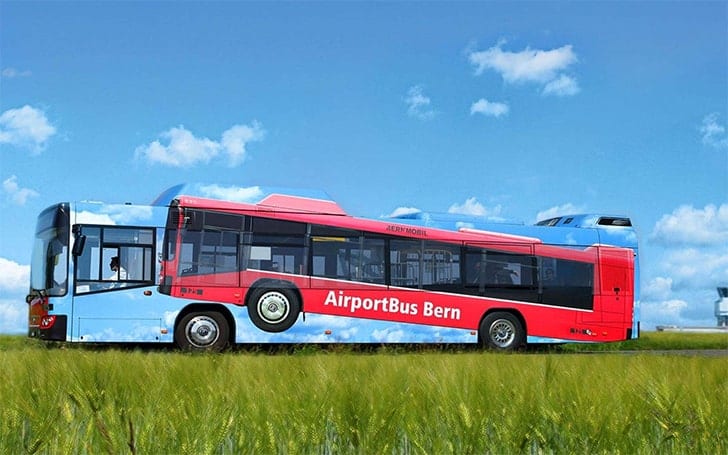
This bus against the natural surroundings makes the best of us do a double-take. At first glance, it looks like this bus is about to lift off.
The Bernmobil bus wrap does a pretty good job of making us look twice and truly digest the ad information. One of the problems tourists have is figuring their way around their new surroundings. It gives tourists the reassurance they need that they’ve taken the right bus to their destination. You could interpret it as a message that tells you to let your worries lift away because you are on the right path.
The estimates have it that seniors have seen about two million commercials on TV. 85% of women are said to be responsible for making purchases in their households. $15 billion goes towards creating ad campaigns that target children each year.
Have A Little Compassion
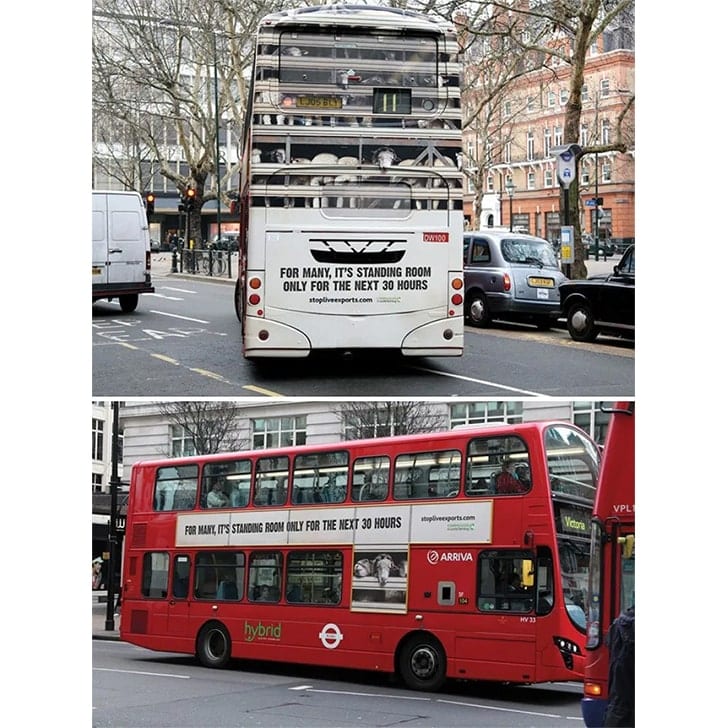
The Compassion in World Farming campaign calls for the end in animal cruelty brought about by subjecting live animals to extended transit times. Part of the campaign included this busvertisement.
It looks as if animals have been cramped up in the vehicle with barely any room left to move around. The text explains it; these animals are subjected to this treatment when being ferried to places as far as 30 hours away. The animals reportedly also go without water on these journeys that can last for days. In 2011, estimates suggest that 223 trucks ferrying live animals passed through Kent Port.
Eurostat estimates that in 2010, 25,417 calves and sheep were exported. The campaign prefers the transportation of meat export ideally, instead of living animals. In the case of the transport of live animals, they called for ethical welfare standards.
Keep The City Clean
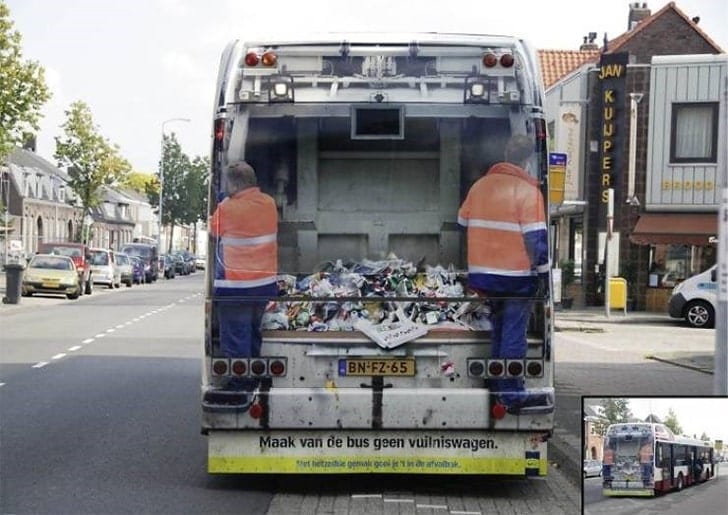
The world over, the problem of waste management, is a never-ending one. It all starts with educating all people to be more mindful of how they dispose of their waste.
Holland came up with this optical illusion bus ad to remind its citizens to pick after themselves. Anyone who comes across this bus would think that it’s a garbage truck, but the message puts everything into perspective. It tells commuters not to turn the vehicle into a garbage truck while there are waste bins available to contain their trash—the message transfers to just about every single facet of our lives.
The bottom line is that trash should go in the waste bin. Each of us is responsible for generating about four pounds of waste every day. Americans are responsible for producing a staggering 21.5 million tons of food-related waste annually.
